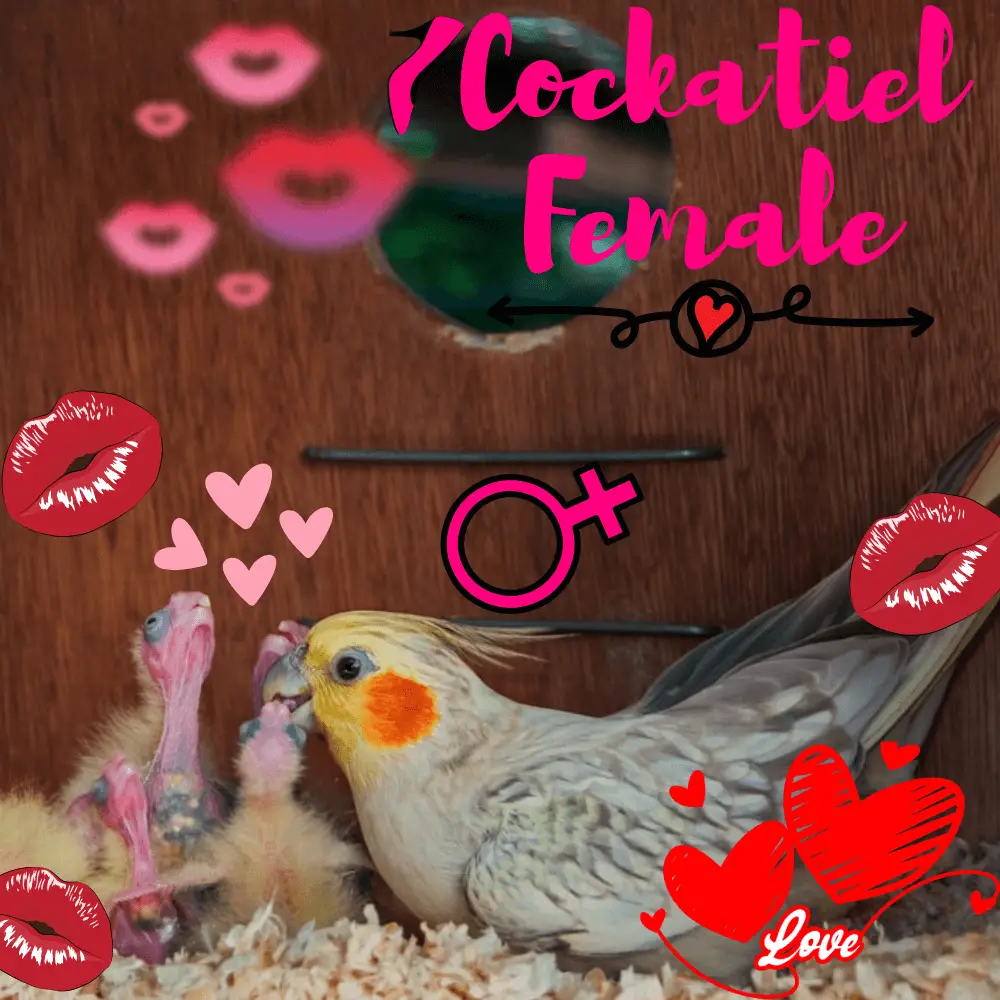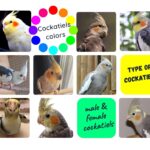Cockatiel female Sexual dimorphism:The gray female cockatiel has a duller cap, hoopoe, cheeks and ear region than the male. The tail feathers are irregularly striped, with shades of pale yellow and dark gray. The sex of the bird can also be determined by its behavior and the colors of its face when it is 3 to 6 months old. An adult bird that whistles, sings and has a brightly colored face is usually a male. However, it has stripes on its tail until its first complete molt, after which its tail becomes dark gray. The determination of sex by DNA is still advised.
Color mutations:
- Pearl (each feather keeps its gray color and is stained with white)
- Albino (white feathers)
- Variegated (variable white spots all over the body)
- Lutino (white and yellow feathers and orange cheeks)
Conditions at home:
- Dimensions of the day cage: A bird cage must be spacious, safe and frequently cleaned. The minimum dimensions are usually 50.8 x 50.8 cm, in order to allow the bird to move and engage in physical activity, and thus prevent obesity.
- Cage location: Install the cage away from hazards such as direct sunlight, smoke from the kitchen, cold temperatures and predators.
- Dimensions of the rest cage: The cage should be 45.7 x 45.7 cm or at least one and a half times the length of the bird, when its wings are fully extended.
- Encouraging physical activity: The cage should be equipped with horizontal bars to encourage the bird to climb, and an open-top cage, ,play area or aviary is essential to allow the bird to exercise. An indoor aviary is easily built using a small caliber mesh. In addition, secure the house from any danger, such as mirrors, ope,n windows and fans, before letting your bird fly freely, and always watch it when it flies.
- Appropriate size of perches: Your bird must have access to at least three perches of different size,s, shapes or textures. The ideal combination, however, is a wooden perch 1.6 cm in diameter, a manzan,ita perch and a therapeutic perch.
- Additional items: You can also provide your bird with a swing, toys, ladders, bel,ls, twigs and destructible and safe material, a bath, etc.
- Water dispenser: The water of the bird should ideally be changed twice a day. It is important to train the cockatiel parakeet to drink from a water bottle as well as from a water bowl, as it likes to perch and send its droppings into the bowls.
Dietary needs of the cockatiel
The bird should be provided with a balanced nutritional diet. This must consist of a granulated feed such as Tropican, 60%; a Mixture of Tropimix seeds and a Tropimix egg mixture occasionally garnished with millet in clusters, at 30 %; and fruits, vegetables, ri,ce, pasta and healthy homemade meals, at 10%. Ordinary seed mixtures can lead to obesity and calcium and vitamin deficiencies. Try to provide the bird with elaborate food or, at least, nutritious seeds such as Tropican feed.
Lighting needed
The cockatiel needs 8-12 hours of natural sunlight or continuous spectrum lighting daily, and 12 hours of uninterrupted rest, especially the female. Be careful, this bird is prone to experience night terrors; it must therefore have a night lamp and the extra toys must be removed for the night.
Time to devote per day to the bird
Ideally, you should spend one quality hour a day with your bird, that is, do activities with it, bathe it, train it or fly it. Caution: Avoid always keeping your bird on you, so that it can develop its independence.
Price of a cockatiel
It sells for between $80 and $300 CAD, depending on the color mutation and age of the bird.
Vulnerability to disease
The cockatiel is a resistant species, but it is prone to obesity, egg retention, candida, and addiction syndrome, such as cockatoos. It is therefore often recommended to have two birds. In addition, birds with a mutation are weaker. Avoid drastic changes in temperature and keep the bird away from dangers.

Wait until the bird is an adult. Males and females are the same before adulthood. After six to nine months, the bird will molt for the first time and new feathers will grow, usually more colorful feathers which will vary by sex.
- Pale or dull plumage could be a sign of poor nutrition, although sometimes it may take several molts before the adult’s bright, colorful plumage develops.
- Do not set up a nest for the chicks, as this could cause them to mate too early, which could endanger the females.
Take a close look at the tail. In normal gray cockatiels, adult females (and all young) have markings under the tail feathers. These are horizontal stripes of alternating colors, for example, light gray-dark gray, white-gray, or yellow-gray, however, some females have irregular dots or patterns. If you can’t see any of these, hold the cockatiel in bright light and examine it again. If you still don’t see any markings, the cockatiel is probably male.
- Lutinos, pale yellow or white cockatiels with circles on the cheeks, can be often identified, as females that have yellow dots under the wings and yellow markings under the tail. You may need bright light to be able to see them.
Compare the heads. In elegant cockatiels, the male usually has more conspicuous feathers on the head, with bright orange dots sticking out over the rest of the yellow plumage. Females have paler orange dots on paler yellow or grayish plumage.
- In some species, only males keep the yellow head after molting while females keep their gray or brown head.
- Bald cockatiels (but not the rest of the body) sometimes produce males without spots on the cheeks and females with very pale spots that are the same color as the plumage on the body.
Compare the plumage on the body. Cockatiels have gray plumage on the body which tends to be darker in males and lighter in females. This is one of the less reliable methods, but it can confirm the conclusions you have drawn with the other methods. Species with plumage other than gray on the body rarely respond well to this kind of identification.
- In some species, the female also has pale yellow dots under the feathers.
- pearl cockatiels, recognizable by white dots on a body, the males lose their “pearls” after the first molt while the females keep them.
Take him to a vet. The last test is based on the anatomy of the bird which should only be done by a veterinarian. Individuals with no experience could harm the bird during this test and are unlikely to be able to tell the difference anyway. Ask the vet to tell you the sex of the animal and they will likely observe the shape of the pelvic bones which tend to be larger in the female. Although the latter is not a completely safe method, there can be a lot of variation between individuals.
- The older the cockatiel, the less likely this method is to work, especially if the bird has been owned by a breeder and has already laid eggs.
- If you want to be completely sure, you have to request a DNA test.

Identify gender according to behavior
Watch for mating rituals. Males are usually the most active birds when it comes to impressing their mates, but they sometimes display this kind of behavior even if there are no other birds around.
- It will bang its beak against objects to make noise and attract the attention of females.
- He will strut around while hissing or banging his beak, which could also be accompanied by hopping and tilting of the head.
- He will pull the tips of the wings away from his body, which will look like a heart shape if you look at him from behind.
Watch the female mating rituals. Females are generally less active in mating rituals and they do not exhibit them if there is no male present.
- They will sit on a low perch, chirp softly, and lift their tail up in the air.
- They will try to feed the male they bonded with or they will try to bond.
Notice methods of masturbation. Most experienced bird owners have noticed that birds rub the anal opening on perches, objects, and even on their owner’s hands. Some birds do this every day and others do it more often. This kind of masturbation is most often seen in males, but there are exceptions.
- In males, you will see them jump on the object in question or stand over it to rub the anal opening.
- In females, you might see similar behavior, but they might also recoil against an object by lifting the tail and leaning forward.
Check the eggs. You won’t be surprised to learn that only females lay eggs, but it won’t help if you find any in a cage with multiple birds. If you want to be sure of the gender of the birds, put them in separate cages with individual nests or record their future behaviors with a camera.
- Females under the age of 18 months should not be given a nest, as they could suffer serious problems if they lay eggs too early.
- If you remove the egg, you will stimulate them to lay again.
- Remember that the egg could be fertilized, although in this case, the activities of the cockatiel couple should be obvious.
How to tell if a Cockatiel Is Male or Female
SOURCE:ParrotNest





















